
People Share How Differently Americans And Europeans Understand Time And Space
Travel the world and you will learn there are obvious differences between cultures, the cuisine, the styles, the languages and even sometimes the toilets – however, you would think that there would be some things that unite us all, like the way we perceive time and space – but you would be wrong.
As one man ranted about on Twitter, Americans have their own way of measuring distances and weights with the imperial system, but it turns out that that is not the only difference. Some of what we perceive about time and distance is based on our own experiences and history. For Americans, a building from the 1600s is a historical landmark, while for Europeans a building like that wouldn’t even deserve a photo. And with distance, Europe has so many countries that are closer together than the states in the U.S so the idea of a 6-hour bus ride would be insane. The following stories show just how much where you grow up affects your view of time and space.
It is still up for debate when the first Americans, the Native Americans, first arrived in America, because more and more evidence continues to be discovered. However, As of now, scientists can say soundly there were people across the Americas at least 15,000 years ago, with even some evidence suggesting as far back as 40,000 years ago. As for the colonists, their date is much much more recent, with people arriving from Europe in the early 1600s. The United States declared independence from the British on July 2, 1776, and signed the Declaration of Independence on July 4, 1776, making the formal country only 243-years-old. This makes the U.S extremely young when compared to Europe. The oldest country in Europe is the microstate of The Republic of San Mario, who gained independence from the Roman Empire September 3rd, 301 AD. They are followed by France who first unified in 486 AD under the name Francia.
A common misconception is that Europe is smaller than the United States. However, when it comes to land mass the two are actually pretty similar the United States is 9,833,000 square kilometers while Europe is 10,180,000 square kilometers. The confusion comes from the disproportioned way maps were designed, and the fact that countries are smaller and closer together, like states in the eastern part of the U.S, unlike those in the western states. For example, Ukraine, the second largest country in Europe (818 miles at its longest) is almost the same size as Texas (801 miles for Texas) the second largest state int the U.S.
So how do you Europe and the United States match up to the rest of the world? The largest city in the world is Shanghai, China with 24,153,000 people, the largest European city is – which is also the fourth largest city in the world – is Istanbul, Turkey with 14.7 million people and the largest U.S city is New York with 8.6 million. The United States not only doesn’t have the largest city by far, but it’s also not even the largest country, coming in third behind Russia and Canada.
202Kviews
Share on FacebookI don't understand those random American comparisons. Seattle to Miami is longer than Paris to Baghdad? How about Skarsvåg in Norway to Heraklion in Greece - it's almost the exact same distance. I also don't understand how "Europe" is a thing for them. "European culture" for example. There's no such thing. Europe is made up of dozens of countries, each with VERY distinct customs and traditions. Even neighbouring countries are worlds apart.
THANK YOU! For the same reasons, I seriously dislike the term "western culture / western countries / western world" within intellectual contexts. Some people may find it petty or nitpicking, but try living in a different country for a while and you'll feel the importance of accuracy.
Load More Replies...It's very cute that people think England is old... I live in Thessaloniki Greece, we celebrated the 2300 year of our city.
Nasos Dimis, let kids have fun :) p.s. we still remember you took our golden fleece :D
Load More Replies...My husband lived in Japan for 4 months on a student exchange program. He met several people including a girl from Montreal Canada who was married to a guy from England. When they were visiting Seattle for her husbands job, we took them out to dinner at a nice restaurant by the waterfront. Heavy on the seafood, the meal started with clam chowder which they were happy with. Then came the main entrees. Their eyes widened. They said "we thought the chowder was the meal." Then it dawned on me that people from other countries don't consume the portions that Americans do. It explains why the American reviews of international restaurants are heavy on the "Not enough food" complaints. Luckily it was rice with Alder Smoked Salmon and they had a fridge in their hotel room. They took the rest back to the hotel and re-heated it the next day for lunch. After that, we either chose restaurants with small portions or found places where we could share meals.
24h car drive in Europe: left from origin country, went through 4 more, just got into the 5th. 24h car drive in America: almost out of the origin state.
Well, in Europe, people literally take an international tour on a bicycle. ♥
Load More Replies...It is interesting like Americans don't understant that Europeans do not like travel by car to much, but one of the factor is, i think, the price of gas. And I also think that in Europe a lots of people uses trains and buses much more - it is cheper and more ecological. But I understand that America is coutry projected for cars, without car you can barely exist there. I am 26 and I do not even own driver license and I have no problems with that. I live in the central Europe.
Generalizing about "America" is as fruitless as generalizing about "Europe". Europe and USA are roughly the same size. To say that all of America is built for cars is silly. Many people in the Northeast live just fine without cars. I'm sure the same could be said about most major cities. And the idea that American culture begins and ends with European colonists is such Euro-centric bull. To the people on here that view the US as a petulant teenager - I view the UK as the ex boyfriend who can't let go. We broke up with you 250 years ago. Get over it already. Go bother one of your other exes. Stop calling. Stop texting. Stop DMing. Stop tagging us in your pictures. Move on! We don't feel 'that way' about you anymore. For those of you who live outside of the US, maybe think of each state as a different country. Georgia and Kansas are vastly different - climate, topography , cuisine, accents, values, relgions, etc. Lumping states together is like lumping Italy and Finland together.
Load More Replies...To think Oxford University is around 1090 AC and older then the Aztecs... Americans who wonder why evertyhing is that much older then in your country... Its not your country originaly. Your ancestors came from here...
No, my ancestors came from West Africa...."Americans" are not all Caucasian.
Load More Replies...We in Finland learn these things at school in history and geography lessons and we don’t focus just in Nordic countries or Europe but the World. I find it odd how people can have so little general education! Also there is around 50 European countries, not just United Kingdom, France, Italy, Spain and Germany... those are always the ones that are mentioned.
The written text of this article proves the author holds the incredible misconception that Europe is a country...it’s a continent folks. That’s where the comparison lies because *states* with a unified government, currency, language, culture under one country, are NOT the same as *countries* with vastly different languages, cultures, currencies, governments, etc.
I don't get how we count length or width of Europe by calculating distance between Paris and Rome? How about Lisboa (Portugal) to Moscow? Or Reykjavík (Island) to Athena?
I grew up on Lake Michigan and was missing the water. So I decided to take a trip to Lake Superior, 179 miles north of where I live now; a little over 2 hours. Had lunch, then drove home. I drove over 300 miles to see a lake and eat some pizza. That's the US.
Load More Replies...Visited my wife's grandmother in Illinois. We live in Mississippi. 22hr round trip. We visited her for an hour.........
I'd also like to note the shortest distance I drive to work is roughly 52 miles one way. Generally 60-80 miles one way. Occasionally 100+ one way. I do this 5 days a week. Occasionally weekends. I get up at 5am and home by 7pm. This is completely normal to me.
Load More Replies...Counterpoint. Moscow to Madrid is over 4,000km. LA to Atlanta is only 3,500km.
Counterpoint to your counterpoint: Seattle to Miami over 5400km. Checkmate ;)
Load More Replies...I loved a two week long trip to Emgland I made. The people were friendly and polite and kept to themselves which is quite nice. But, their sense of travel scale is significantly altered by the population density. I live in Oklahoma and have driven from Tulsa to Oklahoma City to go to dinner with a friend. About 90 miles. That's a major undertaking in the UK. I did like how you could be veyr close to significantly different cultures such as France or Spain. We do not get that here unless you live on the border with Mexico and it's still prety similar on either side.
My friend who is British, when she moved here(US) to around Boston she thought Disney world was basically a short drive away.
It's San Marino, not Mario. And the Francia that unified in 486 wasn't modern day France, but composed the area of both France and Germany - the two “countries“ it was eventually split into.
Still, it was mostly current French territory. The Franks only held a small part of present day Germany. The kingdom of Thuringia occupied the eastern part, the Saxons lived in the North and the kingdom of Bavaria layed in the southeastern part of current Germany.
Load More Replies...I live in the eastern part of Belgium. When we're in America I always say I live very close to Brussels. (50 miles) When local people here talk about driving to Brussels its like they're going to make a multiple day roadtrip. The look of horror on peoples faces when they find out I have to go ALL THE WAY to Brussels for my passport (I'm Dutch and have to go to the embassy ) Also, we freak out Americans when we say we cross two country borders when we go shopping in Aachen Germany, though its only a 45 minute drive.
This is sooo true in many parts of Europe! F.e.: from Belgrade, Serbia, by plane, one can quickly get to the capitals of the following European countries: Bosnia, Croatia, Macedonia, Slovenia, Albania, Bulgaria and Romania in 45 min; Austria, Slovakia, Bohemia and Moldova in 1h15min; Turkey, Italy and Switzerland in 1.45 hrs; etc.
Load More Replies...Loving this! Reminds me of the time I was getting shown around in my cousins car in Sydney and my cousin's husband (Australian born) turn round and asked if we had building as old as the ones in Sydney. I thought he was going to crash the car when I replied "mate, we've got a pub in Glasgow that's older than your country. Lol
I am from Egypt. Everybody shut up! I took a 6 hour bus ride to get a stamp, and went back home in the same day. And our tour guides explains "The New State Era" is the era from nearly year 1500 to year 1300... "BC"!! ؛؛؛؛
Hey, you anglo-americans (smile). 1600??. We, spanish conquistadors were in North American a little bit earlier than that. In 1513, Juan Ponce de Leon explored La Florida and San Agustin was founded in 1565. And a lot of misiones (Misions) all over the Arizona, New México, Texas and California territories BEFORE the English could land in that place.... Jamestown I think. I´m only laughling at you, no harm
It is funny how americans see europe more like a country than like a continent with so much different cultures,languages,politics,currencies ect...
My husband and I drove from southern Wisconsin to the very west tip of Texas, took about 24 hours, crossed 5 states in total not including WI and TX. I think it all depends on the roads you take, traffic, weather, and how many pit stops you have to take to get gas, food, and use the restrooms.
You all suck. I remember when the Earth was but a mere speck of dust orbiting a ball of light no bigger than a standard turnip. Come see me when you've lived through the collapse of one universe, and the birth of the next. Then we'll talk.
Maybe this is why people in the US have such big cars. We do a lot of road trips and a lot of time they are with little planning. It’s nothing for us to plan a trip to another state one day before. Pittsburgh is a day trip. NYC is a three day weekend trip.
I'll still use the excuse that I don't have the time to come and see you after work. Evan though I totally have the time and you just live a short distance away. I just can't be bothered
I don't understand those random American comparisons. Seattle to Miami is longer than Paris to Baghdad? How about Skarsvåg in Norway to Heraklion in Greece - it's almost the exact same distance. I also don't understand how "Europe" is a thing for them. "European culture" for example. There's no such thing. Europe is made up of dozens of countries, each with VERY distinct customs and traditions. Even neighbouring countries are worlds apart.
THANK YOU! For the same reasons, I seriously dislike the term "western culture / western countries / western world" within intellectual contexts. Some people may find it petty or nitpicking, but try living in a different country for a while and you'll feel the importance of accuracy.
Load More Replies...It's very cute that people think England is old... I live in Thessaloniki Greece, we celebrated the 2300 year of our city.
Nasos Dimis, let kids have fun :) p.s. we still remember you took our golden fleece :D
Load More Replies...My husband lived in Japan for 4 months on a student exchange program. He met several people including a girl from Montreal Canada who was married to a guy from England. When they were visiting Seattle for her husbands job, we took them out to dinner at a nice restaurant by the waterfront. Heavy on the seafood, the meal started with clam chowder which they were happy with. Then came the main entrees. Their eyes widened. They said "we thought the chowder was the meal." Then it dawned on me that people from other countries don't consume the portions that Americans do. It explains why the American reviews of international restaurants are heavy on the "Not enough food" complaints. Luckily it was rice with Alder Smoked Salmon and they had a fridge in their hotel room. They took the rest back to the hotel and re-heated it the next day for lunch. After that, we either chose restaurants with small portions or found places where we could share meals.
24h car drive in Europe: left from origin country, went through 4 more, just got into the 5th. 24h car drive in America: almost out of the origin state.
Well, in Europe, people literally take an international tour on a bicycle. ♥
Load More Replies...It is interesting like Americans don't understant that Europeans do not like travel by car to much, but one of the factor is, i think, the price of gas. And I also think that in Europe a lots of people uses trains and buses much more - it is cheper and more ecological. But I understand that America is coutry projected for cars, without car you can barely exist there. I am 26 and I do not even own driver license and I have no problems with that. I live in the central Europe.
Generalizing about "America" is as fruitless as generalizing about "Europe". Europe and USA are roughly the same size. To say that all of America is built for cars is silly. Many people in the Northeast live just fine without cars. I'm sure the same could be said about most major cities. And the idea that American culture begins and ends with European colonists is such Euro-centric bull. To the people on here that view the US as a petulant teenager - I view the UK as the ex boyfriend who can't let go. We broke up with you 250 years ago. Get over it already. Go bother one of your other exes. Stop calling. Stop texting. Stop DMing. Stop tagging us in your pictures. Move on! We don't feel 'that way' about you anymore. For those of you who live outside of the US, maybe think of each state as a different country. Georgia and Kansas are vastly different - climate, topography , cuisine, accents, values, relgions, etc. Lumping states together is like lumping Italy and Finland together.
Load More Replies...To think Oxford University is around 1090 AC and older then the Aztecs... Americans who wonder why evertyhing is that much older then in your country... Its not your country originaly. Your ancestors came from here...
No, my ancestors came from West Africa...."Americans" are not all Caucasian.
Load More Replies...We in Finland learn these things at school in history and geography lessons and we don’t focus just in Nordic countries or Europe but the World. I find it odd how people can have so little general education! Also there is around 50 European countries, not just United Kingdom, France, Italy, Spain and Germany... those are always the ones that are mentioned.
The written text of this article proves the author holds the incredible misconception that Europe is a country...it’s a continent folks. That’s where the comparison lies because *states* with a unified government, currency, language, culture under one country, are NOT the same as *countries* with vastly different languages, cultures, currencies, governments, etc.
I don't get how we count length or width of Europe by calculating distance between Paris and Rome? How about Lisboa (Portugal) to Moscow? Or Reykjavík (Island) to Athena?
I grew up on Lake Michigan and was missing the water. So I decided to take a trip to Lake Superior, 179 miles north of where I live now; a little over 2 hours. Had lunch, then drove home. I drove over 300 miles to see a lake and eat some pizza. That's the US.
Load More Replies...Visited my wife's grandmother in Illinois. We live in Mississippi. 22hr round trip. We visited her for an hour.........
I'd also like to note the shortest distance I drive to work is roughly 52 miles one way. Generally 60-80 miles one way. Occasionally 100+ one way. I do this 5 days a week. Occasionally weekends. I get up at 5am and home by 7pm. This is completely normal to me.
Load More Replies...Counterpoint. Moscow to Madrid is over 4,000km. LA to Atlanta is only 3,500km.
Counterpoint to your counterpoint: Seattle to Miami over 5400km. Checkmate ;)
Load More Replies...I loved a two week long trip to Emgland I made. The people were friendly and polite and kept to themselves which is quite nice. But, their sense of travel scale is significantly altered by the population density. I live in Oklahoma and have driven from Tulsa to Oklahoma City to go to dinner with a friend. About 90 miles. That's a major undertaking in the UK. I did like how you could be veyr close to significantly different cultures such as France or Spain. We do not get that here unless you live on the border with Mexico and it's still prety similar on either side.
My friend who is British, when she moved here(US) to around Boston she thought Disney world was basically a short drive away.
It's San Marino, not Mario. And the Francia that unified in 486 wasn't modern day France, but composed the area of both France and Germany - the two “countries“ it was eventually split into.
Still, it was mostly current French territory. The Franks only held a small part of present day Germany. The kingdom of Thuringia occupied the eastern part, the Saxons lived in the North and the kingdom of Bavaria layed in the southeastern part of current Germany.
Load More Replies...I live in the eastern part of Belgium. When we're in America I always say I live very close to Brussels. (50 miles) When local people here talk about driving to Brussels its like they're going to make a multiple day roadtrip. The look of horror on peoples faces when they find out I have to go ALL THE WAY to Brussels for my passport (I'm Dutch and have to go to the embassy ) Also, we freak out Americans when we say we cross two country borders when we go shopping in Aachen Germany, though its only a 45 minute drive.
This is sooo true in many parts of Europe! F.e.: from Belgrade, Serbia, by plane, one can quickly get to the capitals of the following European countries: Bosnia, Croatia, Macedonia, Slovenia, Albania, Bulgaria and Romania in 45 min; Austria, Slovakia, Bohemia and Moldova in 1h15min; Turkey, Italy and Switzerland in 1.45 hrs; etc.
Load More Replies...Loving this! Reminds me of the time I was getting shown around in my cousins car in Sydney and my cousin's husband (Australian born) turn round and asked if we had building as old as the ones in Sydney. I thought he was going to crash the car when I replied "mate, we've got a pub in Glasgow that's older than your country. Lol
I am from Egypt. Everybody shut up! I took a 6 hour bus ride to get a stamp, and went back home in the same day. And our tour guides explains "The New State Era" is the era from nearly year 1500 to year 1300... "BC"!! ؛؛؛؛
Hey, you anglo-americans (smile). 1600??. We, spanish conquistadors were in North American a little bit earlier than that. In 1513, Juan Ponce de Leon explored La Florida and San Agustin was founded in 1565. And a lot of misiones (Misions) all over the Arizona, New México, Texas and California territories BEFORE the English could land in that place.... Jamestown I think. I´m only laughling at you, no harm
It is funny how americans see europe more like a country than like a continent with so much different cultures,languages,politics,currencies ect...
My husband and I drove from southern Wisconsin to the very west tip of Texas, took about 24 hours, crossed 5 states in total not including WI and TX. I think it all depends on the roads you take, traffic, weather, and how many pit stops you have to take to get gas, food, and use the restrooms.
You all suck. I remember when the Earth was but a mere speck of dust orbiting a ball of light no bigger than a standard turnip. Come see me when you've lived through the collapse of one universe, and the birth of the next. Then we'll talk.
Maybe this is why people in the US have such big cars. We do a lot of road trips and a lot of time they are with little planning. It’s nothing for us to plan a trip to another state one day before. Pittsburgh is a day trip. NYC is a three day weekend trip.
I'll still use the excuse that I don't have the time to come and see you after work. Evan though I totally have the time and you just live a short distance away. I just can't be bothered


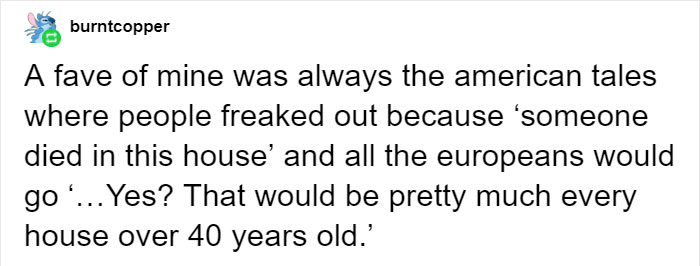


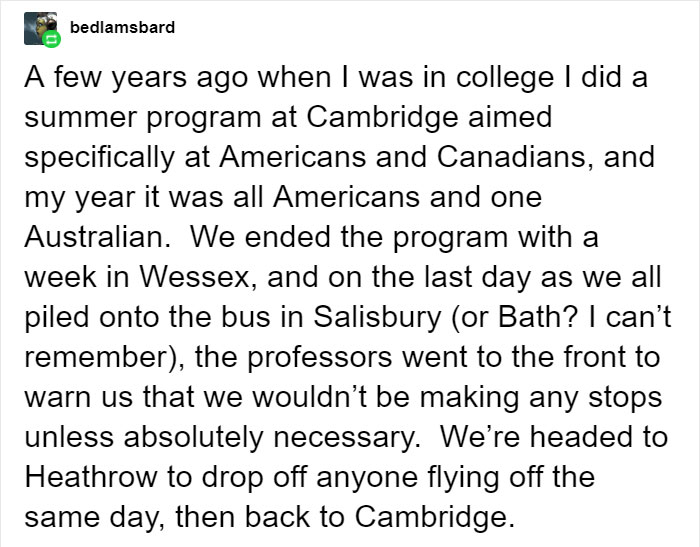




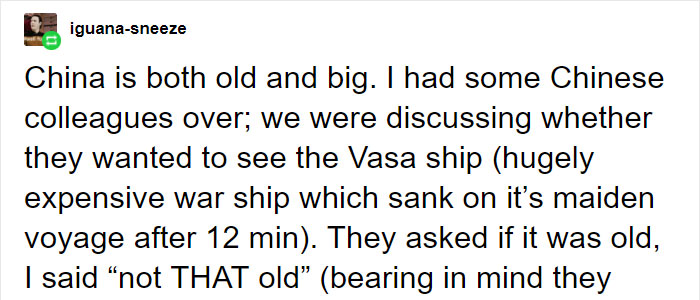
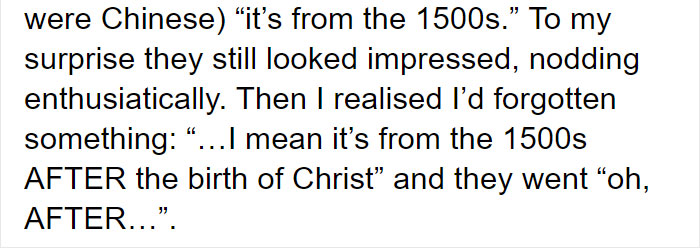





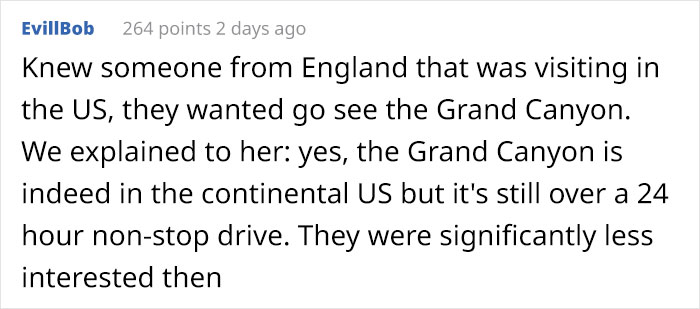





261
108